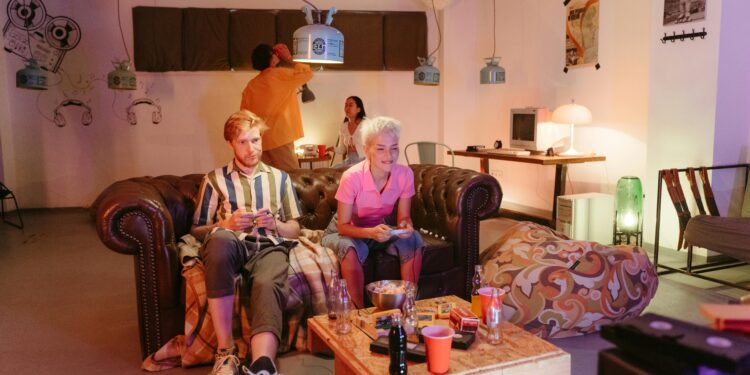The Rise of Parallel Play: When Gaming is Social Without Competition

For years, video games have been defined by their competitive edge—leaderboards, boss battles, and the thrill of victory. But alongside this long-standing tradition, a quieter cultural shift is reshaping digital play: parallel play.
Borrowed from psychology, parallel play describes a mode of interaction where people share the same space but pursue their own activities. In gaming, this often means two or more players coexisting in the same digital world without the need to compete or even collaborate directly. Instead, the focus is on presence, comfort, and simply being alone together.
What is Parallel Play in Gaming?
In childhood development, parallel play is a stage where toddlers play side by side without fully engaging with each other. Translated into digital spaces, it refers to moments when gamers occupy the same world or session but focus on independent activities.
Imagine one player farming in Stardew Valley while another decorates their cabin, or friends hanging out in Minecraft, each building their own structures at their own pace. It’s not about winning or even teamwork—it’s about sharing a space where everyone feels free to set their own rhythm.
This contrasts with solitary play, which takes place in isolation, and with traditional co-op games, which require close coordination and shared objectives. Parallel play sits neatly in the middle, blending companionship with independence.
Why Parallel Play Resonates Today
Several cultural and social forces have pushed this phenomenon into the spotlight:
- Low-pressure connection – In an era of constant digital competition, many players crave interaction without the stress of leaderboards or time-sensitive tasks.
- Mental health benefits – It provides comfort similar to the “body double” technique, where simply having someone nearby (physically or virtually) can reduce anxiety and boost focus.
- Flexibility – Because it doesn’t demand coordination, players can drop in and out without disrupting others, making it ideal for busy lifestyles.
- Accessibility – For gamers who don’t identify as hardcore players, these environments feel more welcoming than competitive formats.
At its core, parallel activities reflect broader digital habits where connection is subtle—chatting while scrolling, co-working in silence, or watching TV alongside friends on separate couches.
Popular Examples
The rise of parallel play can be seen across a range of modern titles:
- Animal Crossing: New Horizons – Friends visit each other’s islands, trade items, or simply hang out while fishing.
- Minecraft (Creative Mode) – Shared servers allow players to build independently but still enjoy each other’s company.
- Stardew Valley – In multiplayer, one player may farm while another mines or fishes—each with their own focus.
- The Sims with online mods – A life simulation that lets players showcase creations and lifestyles without competition.
Even outside traditional gaming, Twitch “study with me” streams and Discord co-working groups reflect the same impulse: the comfort of parallel presence.
The Social Dynamics of Being “Alone Together”
The phrase being alone together, coined by sociologist Sherry Turkle, captures a paradox of modern digital life: we can be deeply connected while doing our own thing. Parallel play thrives on this dynamic, offering sociality without obligation.
For introverts, casual gamers, or anyone seeking digital downtime, this is especially appealing. It provides a sense of community without requiring constant communication or teamwork. In a world of overstimulation, it’s a softer form of belonging.
Parallel Play vs. Other Types of Play
From a developmental perspective, play can be categorised into several stages:
- Solitary play – Independent play with no social interaction.
- Parallel play – Playing side by side without active collaboration.
- Associative play – Independent play with some shared interaction.
- Cooperative play – Shared goals and rules, often competitive.
Games that support parallel play occupy a unique middle ground. They are more social than solitary play, yet less structured than co-op games. This flexibility makes them ideal for casual, creative, or restorative gaming.
Beyond Games: Parallel Playing as a Lifestyle
Interestingly, parallel play in gaming overlaps with wider lifestyle trends:
- Body doubling – A productivity technique where people work side by side (physically or virtually) to stay accountable.
- Digital co-working spaces – Platforms like Focusmate or Discord channels mimic the structure of parallel play, offering silent companionship while working.
- Streaming culture – Viewers and streamers often share parallel activities, whether studying, drawing, or gaming together.
This suggests that parallel play isn’t just a gaming phenomenon—it reflects a deeper human need for shared solitude in digital spaces.
The Future of Parallel Play
Looking ahead, developers are likely to expand parallel play features as demand grows for inclusive and non-competitive experiences. Potential innovations include:
- AI-driven sandbox worlds that adapt to each player’s pace.
- VR lounges where people can hang out casually in immersive environments.
- Cross-platform casual hubs that merge gaming, chatting, and creative tools in seamless parallel settings.
As more people balance wellness with entertainment, parallel could become the dominant style for digital leisure.
5 Ways Parallel Play is Changing Gaming Culture
- Parallel play in gaming emphasises coexistence over competition.
- It appeals to players seeking low-pressure, flexible, and inclusive forms of connection.
- Popular games like Animal Crossing, Minecraft, and Stardew Valley thrive because they encourage parallel dynamics.
- The concept overlaps with broader lifestyle practices like body doubling and co-working, showing its relevance beyond gaming.
- With the rise of VR, AI, and social hubs, parallel play will likely grow as a defining trend in modern gaming culture.
The rise of parallel play reflects a cultural reimagining of what it means to play together. Instead of chasing scores or coordinating every move, players are finding joy in simply sharing digital space. Whether farming, building, or just vibing, parallel play demonstrates that companionship doesn’t have to mean competition.
It’s proof that in the gaming world (as in life) sometimes the best connections happen when we’re free to do our own thing, side by side.








